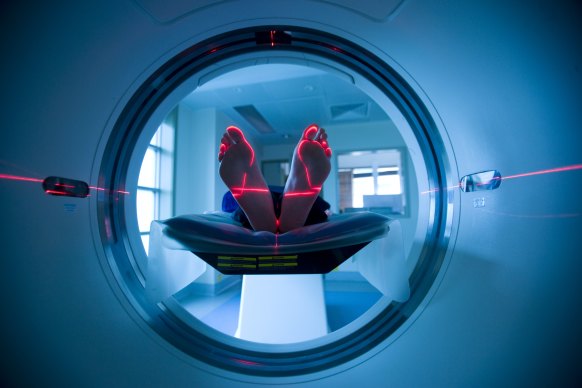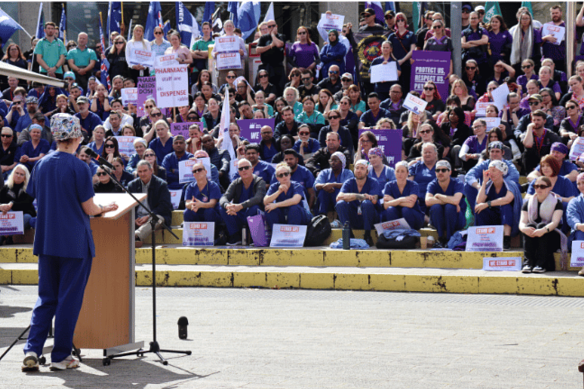Medical imaging delays add to bed lock pain at WA hospitals
How long is too long to wait for medical imaging and other essential medical diagnosis tests in Western Australia?
The answer to that question is continuing to frustrate health workers and patients as wait times in under-resourced medical sectors continue to blow-out, say the Health Services Union WA.

Delays at public hospitals are leading to increased wait-times for medical imaging. Credit: Nic Walker
Frustrations are building after award-winning journalist and Greens candidate Sophie McNeill shared her experience of waiting four days at Fiona Stanley Hospital for an MRI before being sent to another centre for imaging recently.
In an opinion piece published by this masthead today, McNeill recalls nurses breaking down in tears and doctors lamenting the closure of Fremantle Hospital’s emergency department.
“With the incredible wealth that this state generates, our medical heroes shouldn’t be forced to work under such stress,” she writes.
But union secretary Naomi McCrae said the southern suburbs hospital was not the only metro hospital under pressure, with medical imaging technologists, sonographers and their support teams across Perth at breaking point.
“All the medical imaging services in our public hospitals run at full capacity, all the time,” she said.
“The reality is there are always more patients than there are staff and equipment. This means that patients have to wait, and long waits often come with risk.
“It also slows down patient flow and contributes to the ambulance ramping and bed block that staff are constantly managing.”
She said staff at Sir Charles Gairdner Hospital were under significant strain while awaiting the delivery of a third CT scanner funded in the 2023 State Budget.

The Health Services Union WA is considering further industrial action after turning down a second bargaining offer from the Health Department.Credit: Health Services Union WA
Earlier in September, the union rejected a second offer from the Health Department over pay and workforce reforms.
McCrae said while there were no accurate figures available on public health staffing levels, current vacancies, turnover and retention rates there was obvious need for investment in the workforce.
“Every day our emergency departments, like the whole public system, ‘run hot’.”
“It’s well understood and acknowledged that focusing on preventive and community-based health measures, as well as planning for the right workforce, are needed to achieve a more sustainable, cost-effective health system in the long term.”
The Australian Medical Association’s 2024 Public Hospital Report Card, released in April, said hospitals across the country were at breaking point.
The report showed that while 60 per cent of WA ED patients overall were seen within four hours, the state performed the worst in the country when it came to patients under the category three triage “urgent” – with only 32 per cent seen on time.
The Department of Health’s 2023 Your Voice in Health survey also raised concerns that insufficient staffing levels were contributing to long wait times for patients and burnt-out staff.
Australian Nurses Federation of WA state secretary Mark Olson said there had been little to no improvement in workload conditions since the survey’s release.
“We have younger people who are already seeing no end to the worsening conditions deciding to change industries early to our more experienced nurses and midwives we’d rather see mentoring are instead retiring early due to the stress,” he said.
“WA needs to see better movement on the rollout of patient ratios which has been glacial.”
Responding to questions on ambulance ramping on Wednesday, Premier Roger Cook said despite improvements, were was “more to be done”.
“All hospital systems are under pressure,” he told 6PR Radio’s Sean Cowan.
“We’ve had a 20 per cent reduction in ambulance ramping in 2023/24 … but this has been a tough period for our health system.”
A South Metropolitan Health Services spokesperson said Fiona Stanley Hospital was one of Australia’s busiest public hospitals with high demand for specialist treatment and testing.
“We actively manage operational processes, both day to day and in the longer term, to assist with capacity, patient flow and inpatient bed availability whilst ensuring safe, high-quality care,” they said.
“Waitlists for our elective procedures varies by service and patient needs, but overall the median wait-time at FSH decreased by 17 per cent in 2023-24 compared to the previous year, while the number of inpatients treated increased by 7 per cent in the same period.”
Start the day with a summary of the day’s most important and interesting stories, analysis and insights. Sign up for our Morning Edition newsletter.